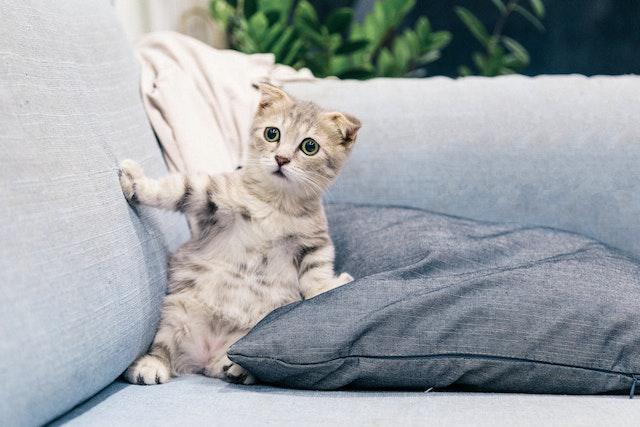15 Common Signs Your New Cat is Adjusting to Your Home

Let’s discuss the signs your new cat is adjusting to your home…
If you’ve recently welcomed a new cat into your home, you might be wondering how to tell if they’re settling in.
Well, fret not, because in this blog post, we’ll explore the telltale signs that your new fur baby is adjusting to their new environment.
So, let’s dive right in!
Signs Your New Cat is Adjusting
Signs that your new cat is adjusting to your home include increased exploration of their surroundings, a relaxed body posture, and a growing bond with their human companions.
Additionally, the cat may display behaviors such as purring, kneading, and grooming themselves, which indicate a sense of comfort and security.
It is important to note that each cat’s adjustment period may vary, but these signs generally indicate a positive transition.
Let’s dive deeper…
The following are some of the most common signs your new cat is adjusting:
1. Using the Litter Box Appropriately
One of the most important signs that your new cat is adjusting to your home is when they start using the litter box appropriately. Cats are naturally clean animals and prefer to relieve themselves in a designated area. When your new cat starts using the litter box consistently and without accidents, it is a clear indication that they are adapting well to their new environment.
To ensure that your cat adjusts to the litter box, make sure to provide a clean and easily accessible litter box. Place it in a quiet and private area of your home, away from high-traffic areas. Additionally, use a litter that your cat is familiar with, as sudden changes in litter type can be confusing for them. Regularly clean the litter box to maintain a clean and inviting environment for your cat.
2. Rubbing and Depositing Their Scent
Cats have scent glands on their faces and bodies, and one way they mark their territory and feel secure is by rubbing against objects in their environment. When your new cat rubs against furniture, walls, or even you, it is a positive sign that they are adjusting to your home. By depositing their scent, they are claiming these areas as their own.
You can encourage this behavior by providing your cat with scratching posts or cat trees. These items not only serve as outlets for your cat to stretch and exercise but also allow them to mark their territory through scent. Additionally, you can use a soft cloth to gently rub your cat’s face and then rub it against various objects in your home. This will help your cat feel more secure in their new environment.
3. Exploratory Adventures Inside Your House
Another sign that your new cat is adjusting to your home is when they start to venture out and explore their surroundings. Initially, cats may feel hesitant and stay in one area, but as they grow more comfortable, they will begin to explore new rooms and spaces.
You can support your cat’s exploratory adventures by creating a cat-friendly environment. Provide hiding spots such as cardboard boxes or cat tunnels where your cat can retreat to if they feel overwhelmed. Place toys and interactive playthings throughout your home to encourage exploration and engagement. Additionally, ensure that your home is safe and free from potential hazards that could harm your cat.
4. Calmer/less Meowing
One of the signs that your new cat is adjusting to your home is if they become calmer and exhibit less meowing. When cats are in a new environment, they may feel anxious or stressed, which can manifest as excessive vocalization. However, as they become more comfortable and secure in their new surroundings, they may start to meow less frequently.
It’s important to note that some cats are naturally more vocal than others, so the decrease in meowing may vary from cat to cat.
If your new cat is gradually reducing their meowing over time, it can be a positive indication that they are adapting well to their new home. This change in behavior suggests that they are feeling more secure and confident in their environment.
5. Kneading and Purring
Another sign that your new cat is adjusting to your home is if they engage in kneading and purring behavior. Kneading is a common behavior in cats where they rhythmically push their paws in and out against a soft surface, such as a blanket or your lap. This behavior is often associated with feelings of comfort and contentment.
When a cat kneads, it indicates that they are feeling relaxed and safe in their surroundings. It is a behavior that is commonly observed in kittens when they are nursing, as it helps stimulate milk production from their mother. Adult cats may continue to knead as a way to express their contentment and establish a sense of security in their new home.
Accompanied by kneading, purring is another positive sign that your new cat is adjusting well. Cats purr when they are content, relaxed, and happy. It is a soothing sound that cats produce by vibrating their vocal cords. If your new cat starts purring in your presence, it indicates that they are comfortable and feel safe around you.
6. A Healthy Appetite
A healthy appetite is another sign that your new cat is adjusting to your home. When cats are stressed or anxious, they may experience a decrease in appetite. However, as they become more familiar with their new environment and feel more secure, their appetite should return to normal.
If your new cat is eating well and showing enthusiasm for their meals, it suggests that they are settling in and feeling comfortable in their new home. A healthy appetite is an essential indicator of their overall well-being and adjustment.
It’s important to note that sudden changes in appetite, such as a significant decrease or increase, should be monitored and discussed with a veterinarian, as they could be a sign of underlying health issues.
7. Regular Water Consumption
One of the first signs that your new cat is adjusting to their new home is regular water consumption. Cats, known for their independent nature, may initially feel stressed or anxious in a new environment, leading to decreased appetite and water intake.
However, as they become more comfortable, you may notice that your cat is drinking water regularly. This is a positive indication that they feel secure and at ease in their new surroundings. Make sure to provide fresh water daily and observe your cat’s drinking habits to ensure they stay hydrated.
8. More Affection and Bonding
Another significant sign that your new cat is settling into your home is an increase in affection and bonding. Cats are known for their unique personalities, and each feline may take a different amount of time to adjust to their new surroundings.
However, as they feel more secure, you may observe your cat seeking out your company, purring more often, and initiating physical contact. This could include rubbing against your legs, curling up in your lap, or even head-butting you gently. These gestures are indications that your new cat is forming a bond with you and considers you a trusted companion.
9. Improved Grooming Habits
Cats are meticulous groomers by nature, and their grooming habits can offer valuable insights into their emotional well-being. When a cat is stressed or anxious, they may neglect their grooming routine. However, as they settle into their new home, you may notice improvements in their grooming habits.
A cat that is adjusting well will spend more time grooming themselves, keeping their fur clean and free from mats. Additionally, they may start grooming other cats in the household, if applicable. This behavior signifies that they are becoming comfortable and establishing social bonds within their new environment.
10. Relaxed Postures:
One of the key signs that your new cat is starting to feel at ease in their new environment is their body language. Cats, being naturally cautious animals, tend to display defensive postures when they feel stressed or threatened. However, as they adjust to their new home, you may notice a shift in their body language towards more relaxed postures.
Look out for signs such as a loose and relaxed body, tail held high, and ears in a neutral position. These indicate that your cat is becoming comfortable and feels secure in their new surroundings. They may also start to stretch out, laying on their back with their belly exposed, which is a clear sign of trust and contentment.
11. Increased Confidence
As your new cat settles into their new home, you may notice a boost in their confidence levels. They may become more willing to explore their surroundings, interact with you and other household members, and engage in playful behavior. This newfound confidence is a positive indication that your cat is adapting well and feels safe in their new environment.
You may observe them venturing out from their hiding spots more frequently, investigating new areas of the house, and even approaching you for attention or playtime. They may also start to vocalize more, which can be a sign of their growing comfort and trust in their new surroundings.
12. More Curious About Their Surroundings
Another sign that your new cat is adjusting to your home is an increased curiosity about their surroundings. Cats are naturally curious creatures, and as they become more comfortable, their curiosity will extend beyond their immediate surroundings.
You may notice your cat exploring different rooms, investigating new objects, and showing interest in things they previously ignored. They may show curiosity towards windows, watching birds, or other outdoor activities. This behavior reflects their growing confidence and indicates that they are becoming more comfortable exploring their new territory.
13. Engaging in Playful Activities
One of the key signs that your new cat is adjusting well to your home is when they start engaging in playful activities. Cats are naturally curious and playful creatures, and when they feel comfortable and secure in their environment, they are more likely to show their playful side.
You may notice your cat chasing toys, pouncing on objects, or even initiating playtime with you or other pets in the household. This active and playful behavior indicates that your cat is feeling relaxed and confident in their new surroundings.
14. Selecting Favorite Napping Spots
Another sign that your new cat is adjusting to your home is when they start to select their favorite napping spots. Cats are known for their love of sleep, and when they feel safe and at ease in their environment, they will seek out cozy and comfortable spots to rest.
These favorite napping spots could be a soft cushion, a warm patch of sunlight, or even a dedicated cat bed. When your cat starts to choose specific spots for their naps, it shows that they have found areas in your home where they feel secure and relaxed.
15. Minimal Hiding and Spending More Time in Open Spaces
Cats are naturally cautious creatures, and it’s common for new cats to initially spend time hiding when they are introduced to a new home. However, as they start to adjust and feel more comfortable, they will gradually spend less time hiding and more time in open spaces.
If you notice your new cat venturing out from their hiding spot and exploring other areas of your home, it’s a positive sign that they are becoming more confident and comfortable in their new surroundings.
They may start to roam around freely, investigate their environment, and even interact with members of the household. This transition from hiding to spending time in open spaces indicates that your cat is starting to feel at home and is gradually adapting to their new environment.
Read more about why your new cat is hiding and not eating.
How to Help a New Cat Adjust to Your Home
Bringing a new cat into your home can be an exciting and rewarding experience. However, it’s important to remember that cats are creatures of habit and may take some time to adjust to their new environment.
To help ease the transition and ensure a smooth integration, here are some practical approaches:
1. Create a safe space: Set up a designated area in your home where your new cat can feel secure. Provide a comfortable bed, food, water, a litter box, and toys. This safe space will serve as their sanctuary until they become more familiar with the rest of the house.
2. Gradual introduction: Introduce your new cat to the rest of your home gradually. Start by allowing them access to one room and gradually expand their territory over time. This will prevent them from feeling overwhelmed and give them a chance to explore at their own pace.
3. Slow introductions to other pets: If you have other pets, introduce them to your new cat slowly and under supervision. Give them time to get used to each other’s scents and gradually allow them to interact in a controlled manner. This will help prevent any territorial issues.
4. Establish a routine: Cats thrive on routine, so establish a consistent schedule for feeding, playtime, and litter box cleaning. This will help your new cat feel more secure and settled in their new environment.
5. Provide vertical spaces: Cats love to climb and explore their surroundings. Install cat trees, and shelves, or provide access to high surfaces where your new cat can perch and observe their surroundings. This will help them feel more confident and in control.
6. Interactive playtime: Engage your new cat in interactive play sessions using toys that stimulate their natural hunting instincts. This not only provides mental and physical stimulation but also helps to build a bond between you and your new feline friend.
7. Patience and gentle approach: Each cat is unique and may require different amounts of time to adjust. Be patient and allow your new cat to approach you at their own pace. Avoid forcing interactions or overwhelming them with attention. Let them come to you when they feel comfortable.
8. Scent swapping: To help your new cat become familiar with your scent and their new home, consider swapping bedding or using a soft cloth to transfer scents between you and your cat. This will help them feel more at ease in their new environment.
9. Provide hiding spots: Cats often feel more secure when they have hiding spots to retreat to. Ensure that there are plenty of options, such as covered beds, boxes, or cat trees, where your new cat can retreat if they feel overwhelmed.
10. Use positive reinforcement: Reward your new cat with treats, praise, and gentle affection when they exhibit positive behavior, such as using the litter box or scratching posts. This will help them associate their new home with positive experiences.
Remember, each cat is an individual, and their adjustment period may vary. By following these practical approaches and showering your new cat with love and care, you can help create a comfortable and welcoming environment for them in their new home.
Read more about helping a new cat adjust.
Frequently Asked Questions
How long does it take for a new cat to adjust to its new home?
Every cat is unique, so the time it takes for a new cat to adjust can vary. Generally, it can take anywhere from a few days to a few weeks for a cat to feel comfortable in a new environment. Patience and providing a safe and nurturing space are key.
What are some signs that my new cat is adjusting well?
Several positive signs indicate your new cat is adjusting well. These can include eating and drinking regularly, exploring its surroundings, using the litter box consistently, engaging in play, and showing curiosity towards you and its new surroundings.
My new cat is hiding a lot. Is that a sign of adjustment?
Yes, hiding is a common behavior for new cats. It’s their way of seeking safety and security in an unfamiliar environment. Allow your cat to hide if it feels more comfortable that way, but also provide opportunities for gentle interaction and gradually introduce it to different areas of the house.
Should I be concerned if my new cat is not eating much?
It’s normal for a new cat to have a decreased appetite initially due to the stress of adjusting to a new home. However, if your cat doesn’t eat for more than 24-48 hours or shows other concerning symptoms, it’s best to consult with a veterinarian to rule out any underlying health issues.
My new cat is constantly vocalizing. Is this a sign of adjustment or distress?
Vocalizing can be a sign of adjustment, especially if your cat is meowing or purring while exploring its new surroundings. However, excessive or unusual vocalization could indicate distress or discomfort. Observe your cat’s behavior closely and consult with a veterinarian if you have any concerns.
Can I speed up the adjustment process for my new cat?
While you cannot rush the adjustment process, there are steps you can take to help your new cat feel more comfortable. These include providing a quiet and safe space, maintaining a consistent routine, offering plenty of toys and scratching posts, and gradually introducing them to other family members or pets in a controlled and supervised manner. Remember, patience is key when helping your new cat adjust to its new home.
Read more about why cats find a new home.
Conclusion
In conclusion, when it comes to your new furry feline friend, there are a few telltale signs that they’re settling in just right.
From confidently exploring their surroundings to curling up in your lap, your cat’s comfort is evident in their actions.
So, keep an eye out for these positive indicators and rest assured that your new cat is well on their way to becoming a cherished member of your family.





![Do Cats Need To Go Outside [Pros & Cons] Do Cats Need To Go Outside](https://petcreeks.com/wp-content/uploads/2021/08/Do-Cats-Need-To-Go-Outside-768x644.jpg)
![New Cat Hiding And Not Eating [Explained] New Cat Hiding And Not Eating](https://petcreeks.com/wp-content/uploads/2023/02/New-Cat-Hiding-And-Not-Eating-768x555.jpg)